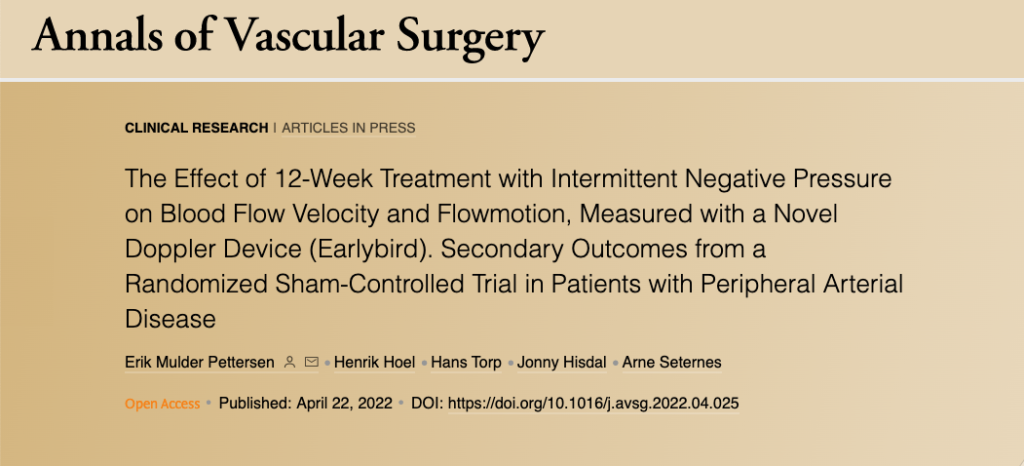New Study confirms:
Positive longterm effect of FlowOx therapy in patients with peripheral arterial disease (PAD)
EXECUTIVE SUMMARY
The Effect of 12-Week Treatment with Intermittent Negative Pressure on Blood Flow Velocity and Flowmotion, Measured with a Novel Doppler Device (Earlybird). Secondary Outcomes from a Randomized Sham-Controlled Trial in Patients with Peripheral Arterial Disease
Erik Mulder Pettersen | Henrik Hoel | Hans Torp | Jonny Hisdal | Arne Seternes

Background
Treatment with intermittent negative pressure (INP) is proposed as an adjunct to standard care in patients with peripheral arterial disease (PAD). The aims of this study were to evaluate the applicability of a novel ultrasound Dopplerdevice (earlybird) to assess blood flow characteristics in patients with PAD during a treatment session with INP, and whether certain flowproperties could determine who could benefit from INP treatment.
Methods
Secondary outcomes of data from a randomized sham-controlled trial were explored. Patients were randomized to 12 weeks of treatment with 40 mm Hg or 10 mm Hg INP, for one hour twice daily. Earlybird blood flow velocity recordings were made before and after the 12-week treatmentperiod and consists of a 5-min recording in rest, 3-min during INP treatment and 5-min recording after ended INP test-treatment. Mean blood flow velocity (vmean), relative changes in flow and frequency spectrum by Fourier-transform of the respective bandwidths of endothelial, sympathetic, and myogenic functions, were analyzed for the different series of blood flow measurements.
Results
In total, 62 patients were eligible for analysis, where 32 patients were treated with 40 mm Hg INP. The acquired recordings were of good quality and were used for descriptive analyses of flow characteristics. An immediate increase in vmean during the negative pressure periods of the INP test-treatment was observed in the 40 mm Hg INP treatment group at both pre- and post-test. There was a significant difference between the treatment groups, with a difference between the medians of 13.7 (P < 0.001) at pre-test and 10.7 (P < 0.001) at posttest. This finding was confirmed with spectrum analysis by Fourier-transform of the bandwidth corresponding to INP treatment. The change in amplitude corresponding to myogenic function after 12-weeks of treatment, was significantly different in favor of the 40 mm Hg INP treatment group. We were not able to detect the specific flow characteristics indicating who would benefit INP-treatment.
Conclusions
Earlybird is an applicable tool for assessing blood flow velocity in patients with PAD. Analysis of the flow velocity recordings shows that INP induces an immediate increase in blood flow velocities during INP. The positive effects of INP may be attributed to recruitment of arterioles, and thereby, increasing blood flow. In these analyses, no flow characteristics were determined which could predict who would benefit INP treatment.
You can download the article in full here!
If you would like to know more about our progress or our product, please contact us at info@flowox.com